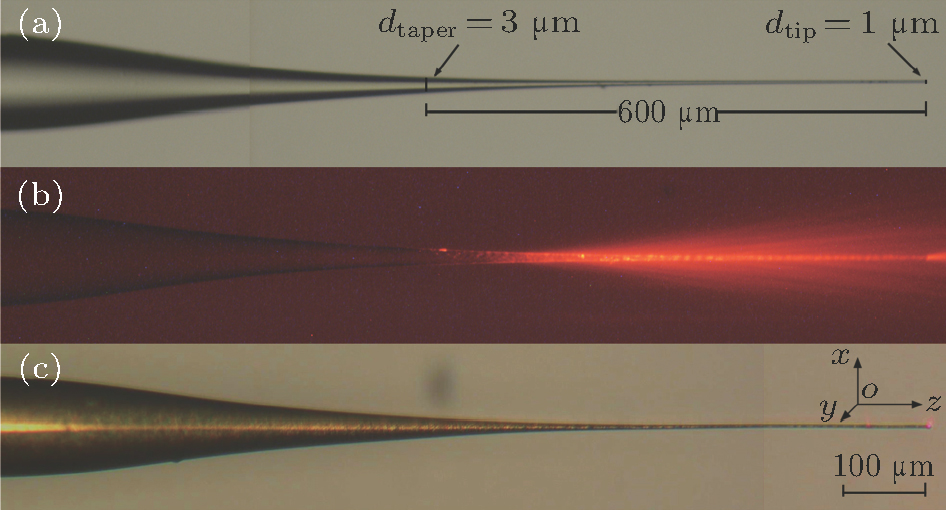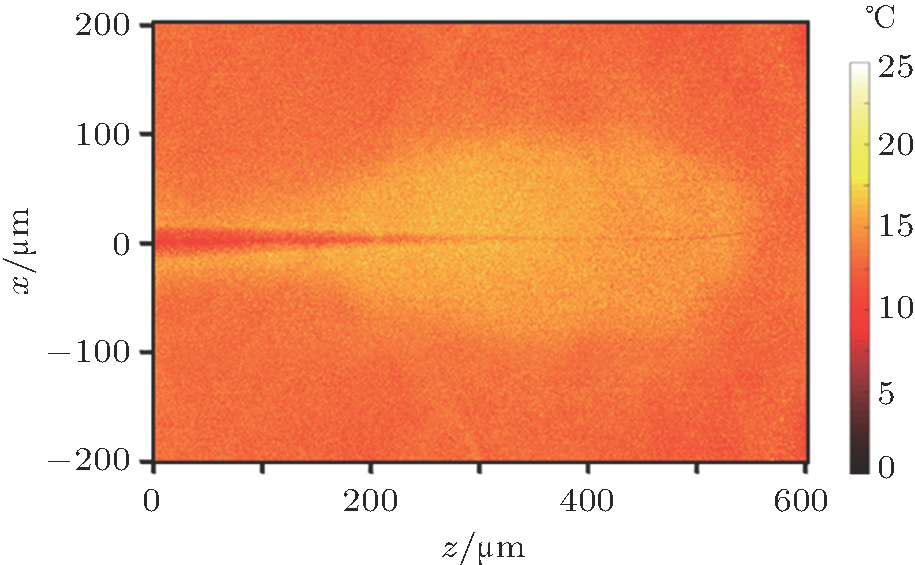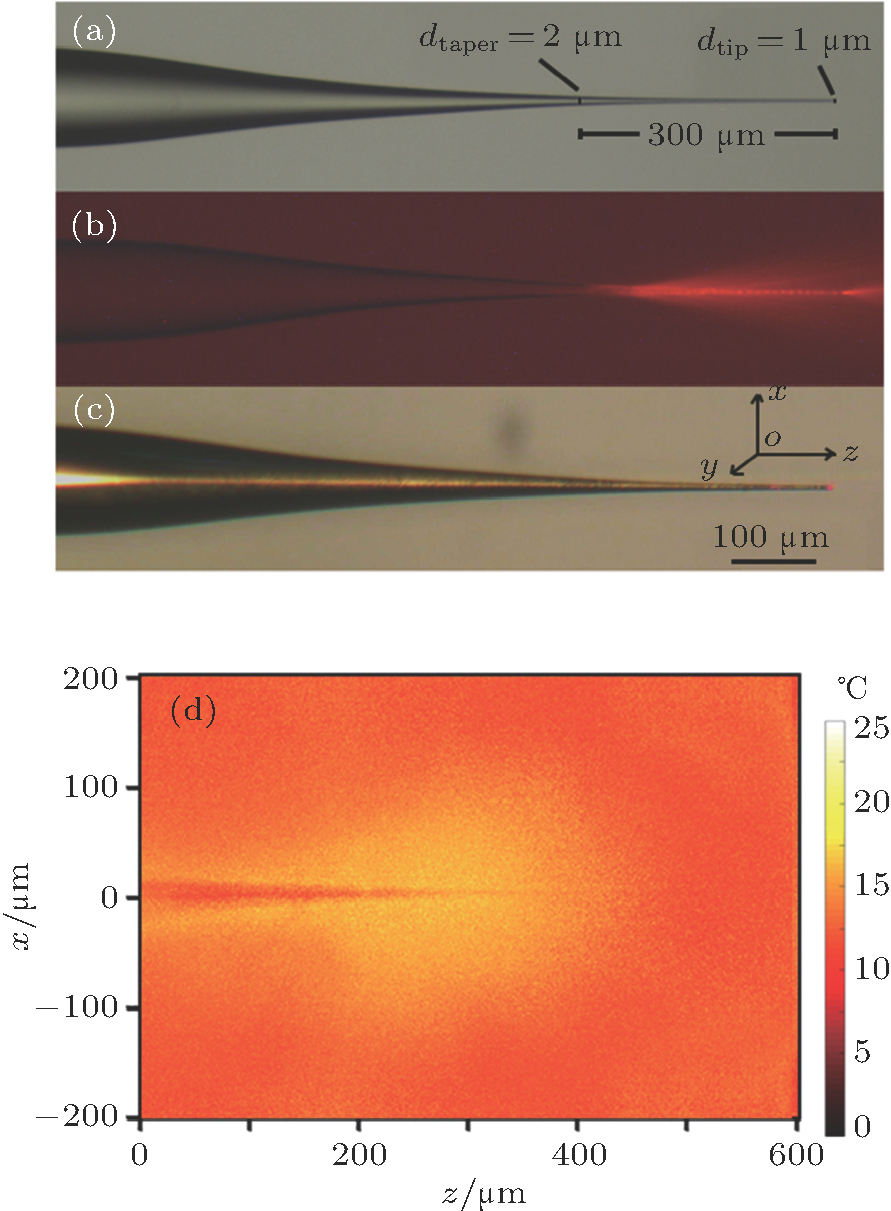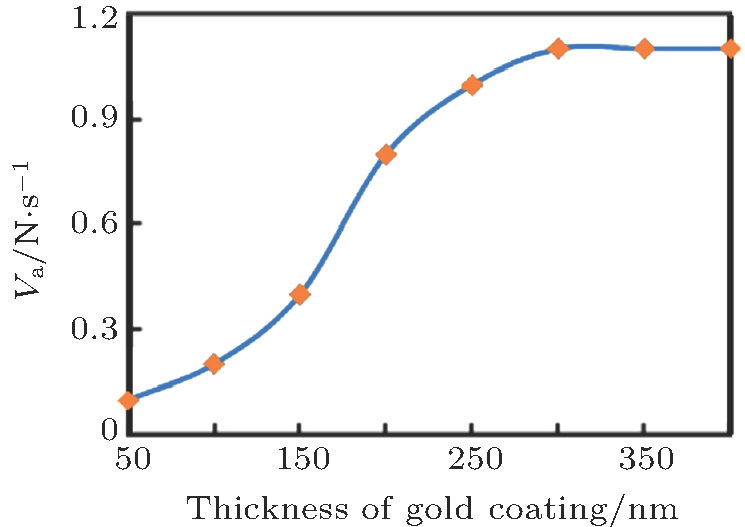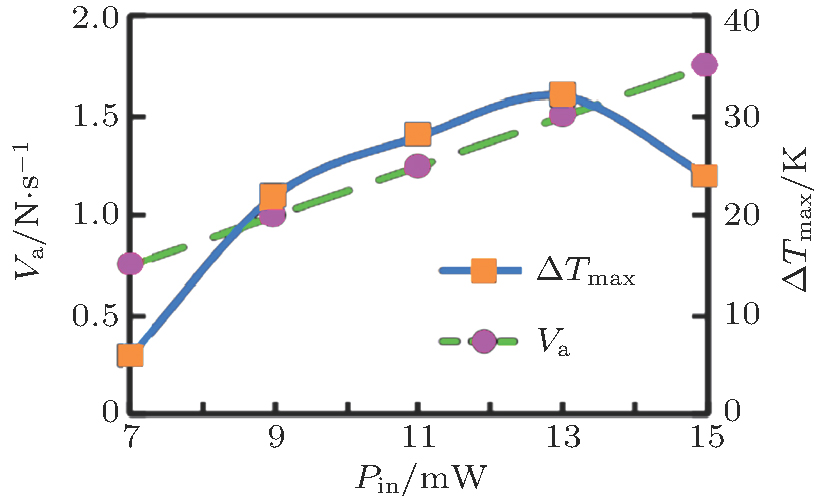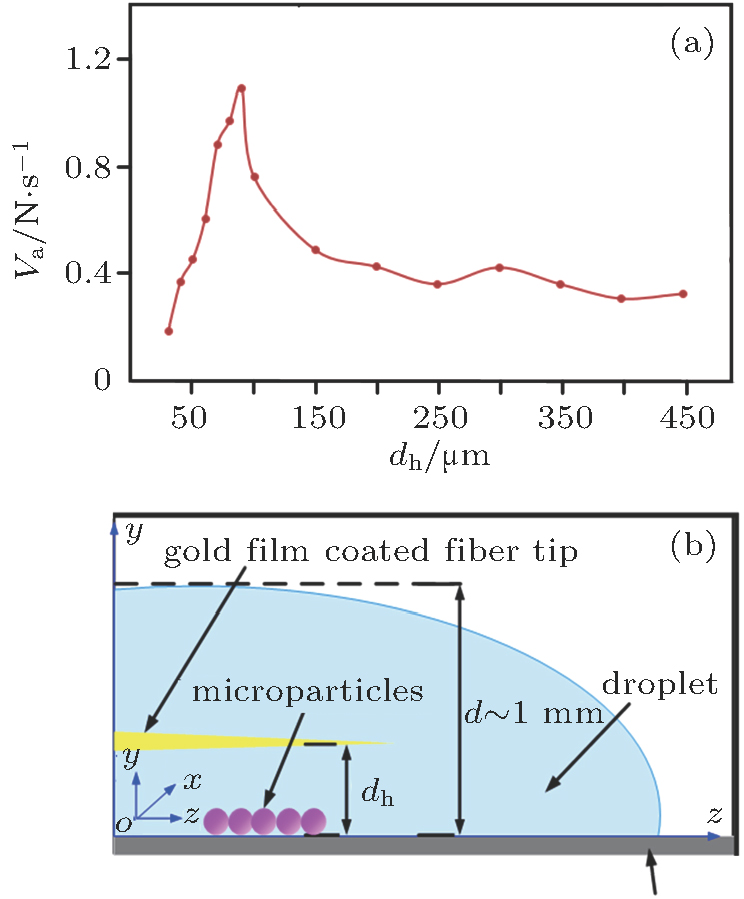† Corresponding author. E-mail:
Project supported by the National Natural Science Foundation of China (Grant Nos. 11574061, 61405043, and 61675053), the 111 Project, China (Grant No. B13015), and the Fundamental Research Funds for Harbin Engineering University of China.
Water purification is required for environmental protection. In this paper, we propose and demonstrate a rapid, effective and low-cost approach to collect numerous impurities (microparticles) in water on the basis of laser-induced thermal convection. We introduce a heat source by using a fiber tip, which is fabricated into a non-adiabatic-tapered shape. In order to improve the laser power absorption efficiency, we coat a gold film with a thickness of 300 nm on the fiber tip. Due to absorption, the laser power transferred from the fiber to the water results in thermal convection. The forces generated from the thermal convection drive the microparticles to move towards the fiber tip, thereby performing microparticle collection and achieving water purification. Laser-induced thermal convection provides a simple, high-efficiency and low-cost method of collecting microparticles, which is a suitable and convenient for local water purification.
Water purification is strongly related to people’s livelihood and environmental protection. Drinking water is contaminated with thousands of compounds.[1] Some pollutants and disinfection byproducts can be toxic to the human body.[2–4] Currently, there are numerous ways to purify drinking water. Natural sedimentation[5,6] is commonly used for collecting heavy particles. Biofiltration[7] can be implemented in drinking water filters through its biological treatment function, and protein-like materials can be removed. Electrocoagulation,[8–10] a process that generates coagulant electrochemically, has been reported to be efficient in removing a wide range of electroplating pollutants from water. Micro- and nanomaterials with unique optical and electrical properties can be used to decompose dyes in water under UV and visible light irradiation.[11] However, these methods are restricted by complex devices and special materials for chemical reactions. Among the various methods used collect the impurities (microparticles) in water, optical trapping[12] is a typical representative. Optical tweezers may trap and manipulate microparticles, whose diameters range from a few nanometers to tens of micrometers.[13–16] The magnitude of the optical trapping force is usually on the scale of pN, and the effective trapping range is on the scale of 
The light source power is introduced by a non-adiabatic tapered shape fiber tip with a gold film coating. This gold film helps to absorb the laser power leaking from the fiber tip and transfer it to heat. The heat is absorbed by the water around the fiber tip to perform a temperature gradient distribution, producing convection. The forces generated from the thermal convection drive the microparticles to move from the low-temperature area to the high-temperature area. By using this laser-induced thermal convection method, we can drive numerous microparticles to accumulating quickly and easily. In addition, we can realize microparticle accumulation by using a low input light power because of the high-efficient light energies absorbed by the gold film.
Unlike the heating and tapering procedure of an adiabatic shape fiber tip,[31] a non-adiabatic shape fiber tip was fabricated to ensure the laser power leakage from the fiber (see Fig.
Silica fiber is temperature-insensitive. If the fiber tip is not gold-coated, the temperature increase of the solution is mainly caused by the special wavelength absorption of the water solution. When the laser wavelength is 



By using the fluorescence dye method, we obtained the temperature distribution near the fiber tip. We employed Rhodamine B as the fluorescence dye. The concentration of Rhodamine B solution was 2 mg/L, whose temperature dependence has been well documented.[35,36] In the measurements, we employed a 532 nm green laser to excite the fluorescence and employed a charge-coupled device (CCD) to obtain the temperature information. Figure 
The added temperature of water solution near the fiber tip produced a temperature gradient distribution in the solution. Thus, the density of the water solution changed along with temperature distribution, causing the buoyancy lift in unit volume to change,[37] and finally leading to convection in the water solution. The larger the temperature difference was, the stronger the convection was. We could control the microparticle accumulating velocity by changing the temperature distribution, which was finally controlled by the input laser power. Due to the non-adiabatic tapered shape, a great deal of laser power leaked out from the fiber tip. The output laser power was absorbed by the gold coating to generate the heat, which was then absorbed by the water solution near the fiber tip. The absorption of heat produced the temperature gradient distribution near the fiber tip, leading to the convection of the solution. The convection caused the microparticles in the solution to move from the low-temperature area to the high-temperature area, driving the microparticles to move towards the fiber tip and achieving the accumulation.
Figure 

Figure
There are some factors affecting the microparticle accumulation.
The shape of the fiber tip can affect the distribution of the temperature field, which influences the convection flow field, and finally the microparticle accumulation. Comparing the long non-adiabatic fiber probe tip (being 

The results indicate that the shape of the temperature field introduced by the short fiber tip is circular and therefore it accumulates the microparticles and arranges them in a circular shape (see Fig.
Comparing the microparticle accumulation results between the long and short fiber probe, the accumulating velocity introduced by the long fiber probe was large. In addition, the length of the fiber probe affected the arrangement shape of the accumulated microparticles.
The microparticle-accumulating velocity is related to the thickness of the gold coating. In a range of 0–300 nm, the thicker the gold coating is, the higher the temperature of the solution near the fiber probe is, and the larger the microparticle accumulating velocity is (see Fig.
The microparticle-accumulating velocity (Va) is related to the microparticle concentration (C) in the solution. In our experiment, when the microparticle concentrations were 0.2625 mg/mL, 0.5250 mg/mL and 0.7875 mg/mL respectively, the microparticle accumulating velocities were, respectively, 0.42N s−1, 1.11N s−1 and 1.67N s−1, where N is the microparticle number (see Fig.
The microparticle-accumulating velocity (Va) is related to the laser source power (Pin). When the microparticle concentration of the solution is 0.5250 mg/mL, we adjust the power of laser source to measure the microparticle-accumulating velocity. Here we choose Pin = 7, 9, 11, 13 and 15 mW, respectively. According to Fig. 
When the density and the kinematic viscosity of the microparticles are fixed, the microparticle-accumulating velocity is related to the microparticle size in the same convection flow distribution field. The distribution of the convection flow is uneven in the vertical (x-axis) direction. The convection velocity is large near the heat source and small near the boundary, including the interface between the air and water surface and the bottom of the substrate. When two microparticles of different sizes are placed on the bottom of the substrate, due to the unevenness of the convection flow distribution near the microparticles, the forces generated from the convection flow are different. The larger the microparticle diameter is, the larger the total force integral of the microparticle surface is, and the larger the microparticles moving velocity is. Figure 



The microparticle-accumulating velocity is also related to the convection flow field distribution. In our experiment, the volume of the water solution is ∼2 mL, and the thickness of the water solution is ∼1 mm (d = 1 mm) (see Fig.
The depth of the fiber (dh) affects the distribution of the convection flow field, which influences the microparticle-accumulating velocity. We measure the microparticle-accumulating velocity versus dh in a range from 





We have successfully demonstrated microparticles accumulating in a water solution on the basis of laser-induced thermal convection. We fabricated a fiber tip into a non-adiabatic tapered shape and plated a gold film on the fiber tip to produce a lot of heat in the solution near the fiber tip. The large heating change produced a temperature gradient distribution in the solution, leading to natural convection. By using this laser-induced convection effect, we could drive numerous microparticles to accumulate quickly, easily and simply. This method provides a rapid and low-cost approach to removing microparticles from a water solution and may be applied to local water purification.
| [1] | |
| [2] | |
| [3] | |
| [4] | |
| [5] | |
| [6] | |
| [7] | |
| [8] | |
| [9] | |
| [10] | |
| [11] | |
| [12] | |
| [13] | |
| [14] | |
| [15] | |
| [16] | |
| [17] | |
| [18] | |
| [19] | |
| [20] | |
| [21] | |
| [22] | |
| [23] | |
| [24] | |
| [25] | |
| [26] | |
| [27] | |
| [28] | |
| [29] | |
| [30] | |
| [31] | |
| [32] | |
| [33] | |
| [34] | |
| [35] | |
| [36] | |
| [37] |


